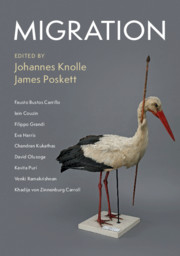Book contents
- Migration
- The Darwin College Lectures
- Migration
- Copyright page
- Contents
- Figures
- Notes on Contributors
- Acknowledgements
- Introduction
- 1 Black and British Migration
- 2 Immigration and Freedom
- 3 Art and Migration
- 4 Refugees and Migration
- 5 Migration of Disease
- 6 The Partition of India and Migration
- 7 Migration in Science
- 8 Animal Migration
- Index
4 - Refugees and Migration
Published online by Cambridge University Press: 25 March 2020
- Migration
- The Darwin College Lectures
- Migration
- Copyright page
- Contents
- Figures
- Notes on Contributors
- Acknowledgements
- Introduction
- 1 Black and British Migration
- 2 Immigration and Freedom
- 3 Art and Migration
- 4 Refugees and Migration
- 5 Migration of Disease
- 6 The Partition of India and Migration
- 7 Migration in Science
- 8 Animal Migration
- Index
Summary
This chapter explores the intersection between refugee movements and the broader phenomenon of human mobility today. My starting point is the experience of two young refugee women, Mariam and Semira.1 They were born and grew up in Eritrea – a country which they describe as beautiful, but where ‘security and hope are scarce for most people’. In Eritrea, military service is compulsory, and in practice, for many, extends for several years. Mariam and Semira, like tens of thousands of young Eritreans before them, fled the country after prolonged periods of service, their requests for demobilisation denied. They embarked on a dangerous journey through Sudan, where they first met, and across the border to Libya, travelling at high speed on pick-up trucks for a month through the harsh desert, watching others fall off and die of injuries or thirst, themselves surviving on biscuits and water.
- Type
- Chapter
- Information
- Migration , pp. 79 - 95Publisher: Cambridge University PressPrint publication year: 2020



